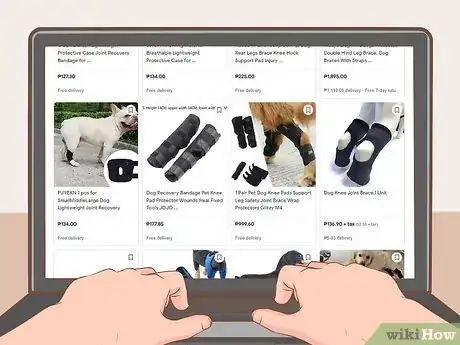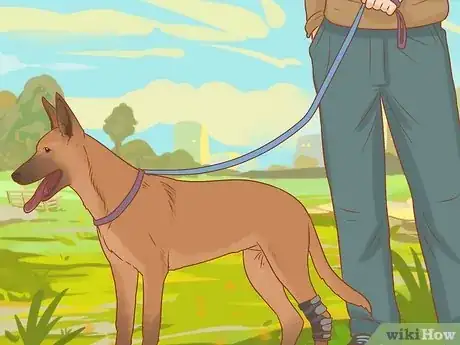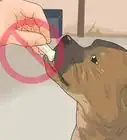This article was co-authored by Beverly Ulbrich and by wikiHow staff writer, Hannah Madden. Beverly Ulbrich is a Dog Behaviorist and Trainer and the Founder of The Pooch Coach, a private dog training business based in the San Francisco Bay Area. She is a Certified CGC (Canine Good Citizen) Evaluator by the American Kennel Club and has served on the Board of Directors for the American Humane Association and Rocket Dog Rescue. She has been voted the best private dog trainer in the San Francisco Bay Area 4 times by SF Chronicle and by Bay Woof, and she has won 4 "Top Dog Blog" awards. She has also been featured on TV as a dog behavior expert. Beverly has over 18 years of dog behavior training experience and specializes in dog aggression and anxiety training. She has a Master of Business Administration from Santa Clara University and a BS from Rutgers University.
This article has been viewed 3,825 times.
If you have a super active dog who loves to run or jump, you may have to help them heal from a knee injury at some point. Using a knee brace is a great way to take pressure off of their joints or ligaments while they heal, but making one yourself isn’t recommended by experts. In this article, we’ll go over the safety reasons why making a homemade knee brace isn’t ideal, as well as some alternatives you can try.
Steps
Alternatives to Making a Homemade a Knee Brace
-
1Purchase a knee brace from your vet. Studies show that knee braces help take the pressure off of your dog’s joints and ligaments so that they can heal.[2] If your dog has a knee injury, your vet may recommend buying a knee brace. You can purchase one directly from your vet to get a quality, professional-backed recommendation that fits your dog perfectly.
- Pricing can vary from vet to vet. You can expect to spend anywhere from $40 to $150 if you buy a knee brace from a veterinarian.
-
2Buy a knee brace online. Online retail stores sell dog knee braces in all shapes and sizes. Get a recommendation from your vet on the size you should buy, and make sure the measurements match up with your dog’s leg before you purchase.
- Most knee braces slide on with Velcro straps so you can easily put them on your dog without hurting them. If you’re having any issues, call your vet for help.
Caring for a Dog with a Knee Injury
-
1Limit your dog’s activity until their knee heals. Running, jumping, and climbing can all injure your dog’s knee further. If your dog has injured their knee, try to get them to rest as much as possible.[3] Try keeping your dog in their crate as often as you can, and use a short leash to take them out for potty breaks.
- You can stimulate your dog’s mind to tire them out by using food puzzles during meal times.
- The amount of time you’ll need to limit your dog’s activity depends on how severe their injury is. In general, you should try to get your dog to rest for 1 to 2 weeks, or longer if it’s recommended by your vet.
-
2Give your dog anti-inflammatories from your vet for pain relief. Anti-inflammatory medication, like carprofen, helps reduce swelling in your dog’s joints, which can further healing. Plus, anti-inflammatories can also help reduce any pain or discomfort your dog is in.[4] Talk to your vet to get a prescription for your dog, and be sure to follow the proper dosage for your dog’s size and weight.
-
3Buy your dog a custom knee brace. Custom knee braces are long-term braces that can help heal small knee injuries. If your dog has injured their knee multiple times or if it’s a small injury, your vet may recommend a custom knee brace for them.[5] Talk to your vet about your treatment options before you buy your dog a custom knee brace. Ortho Pets is the largest retailer for custom dog knee braces, and you can either purchase online or buy them through your veterinarian.
- Custom knee braces usually go hand in hand with rehabilitation therapy. Studies show that core-strengthening exercises, like balance exercises on a wobble board, can help your dog prevent future knee injuries.[6]
-
4Talk to your veterinarian about surgery for your dog. Severe or recurring knee injuries may need a more permanent fix. If your veterinarian recommends it, your dog may need to undergo surgery for their knee problems to go away entirely. Surgery is especially common for larger dogs who weigh over 22 pounds (10.0 kg), since their knees have a harder time healing on their own.[7]
- Not every knee injury requires surgery to be fixed. If you’re not sure, talk to your vet about your next steps.
References
- ↑ http://csu-cvmbs.colostate.edu/Documents/orthopaedics-cruciate-ligament.pdf
- ↑ https://avmajournals.avma.org/view/journals/ajvr/78/1/ajvr.78.1.27.xml
- ↑ http://csu-cvmbs.colostate.edu/Documents/orthopaedics-cruciate-ligament.pdf
- ↑ http://csu-cvmbs.colostate.edu/Documents/orthopaedics-cruciate-ligament.pdf
- ↑ http://csu-cvmbs.colostate.edu/Documents/orthopaedics-cruciate-ligament.pdf
- ↑ https://news.wsu.edu/press-release/2022/02/17/core-strength-could-help-dogs-avoid-knee-injuries/
- ↑ https://vcahospitals.com/know-your-pet/cruciate-ligament-rupture-in-dogs































































